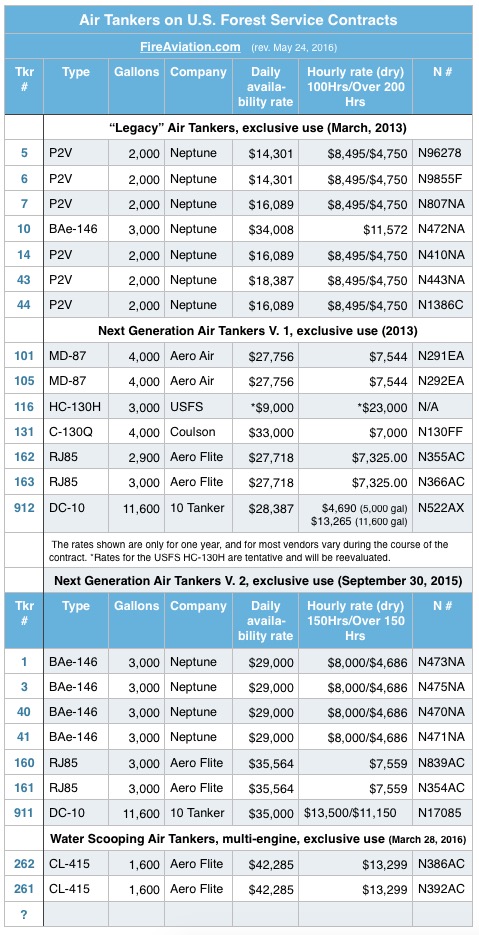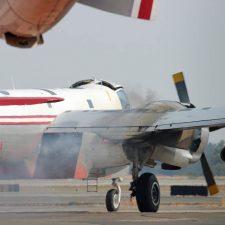Above: Air tanker 43, a P2V, fires up an engine at Redding, California, August 7, 2014. Photo by Bill Gabbert.
(UPDATED May 24, 2016)
The number of large and very large air tankers on exclusive use contracts for fighting wildland fires will be about the same as the way the fire season ended in 2015, with 21 signed up, counting the HC-130H operated by the U.S. Forest Service.
Here is the breakdown by type of aircraft, and then by company:
P2V: 6
BAe-146: 5
RJ85: 4
DC-10: 2
C-130: 2
MD87: 2
CL-415: 2
Neptune: 11
Aero Flite: 6
Aero Air: 2
10 Tanker: 2
Coulson: 1
U.S. Forest Service: 1
The numbers above only include the large and very large air tankers that are on exclusive use contract. In addition the USFS will have between two and three water scooping amphibious twin engine CL-415 air tankers. One is on contract now and they have a solicitation out now that will add one or two more to the fleet.
The plans, which could change, are for three of the P2Vs to begin work in March, on the 3rd, 18th, and 28th. Most of the other large air tankers will start in April, but six will come on duty in May and June. All of the next-generation large air tankers are contracted for a minimum of 160 days while the “legacy” aircraft are signed up for 140 to 180 days.
There will also be a large number of single engine air tankers (SEATs), perhaps dozens, on exclusive use. The Bureau of Land Management is responsible for that contract and we hope to hear in April or May how that turned out. The USFS has a solicitation out for one SEAT and the Bureau of Indian Affairs will have at least one amphibious water-scooping SEAT, an Air Tractor 802F (N6159F) supplied by Aero Spray, and expect to add one more in the next few weeks, according to Robyn Broyles, spokesperson for the BIA.
Randy Eardley of the BLM told us they will have four AT 802Fs on 75-day contracts working out of Fairbanks this year. He said there are two each from Air Spray and Aero Spray.
(The chart below was revised May 24, 2016. Some costs were updated and there was some swapping of aircraft from one Next Gen contract to another.)

If you want to print the list, this .pdf document will probably turn out better than the image above.
There will also be at least five or six large air tankers available on Call When Needed contracts. Several companies are in the process of converting more airliners into air tankers and when those are finished and carded might be added to the CWN list.
If the wildfire season turns into more than what these 27 air tankers can handle, the military can activate up to eight C-130s equipped with the pressurized slip-in 3,000-gallon Modular Airborne FireFighting System, or MAFFS. However a MAFFS unit is being used by one of the HC-130H aircraft that is in the process of being transferred from the Coast Guard to the USFS. That leaves just seven MAFFS units available. In a few years all seven of the former Coast Guard HC-130Hs will be de-militarized, will have gone through heavy maintenance, and will be equipped with a removable gravity-powered retardant delivery system, again freeing up all of the MAFFS equipment.

Another source for air tankers are the eight CV580s available through agreements with the state of Alaska and Canada.
On March 1 we wrote about the recently awarded exclusive use contracts for 34 large Type 1 helicopters. The USFS contracts issued three years ago for 31 exclusive use Type 2 helicopters are still in effect.
Jennifer Jones, spokesperson for the USFS, told us there are “approximately 200 helicopters of all types [that] may be available through Call When Needed Contracts”.
Later we will have more details about the status of the seven HC-130H aircraft being transferred to the USFS from the Coast Guard and converted to air tankers.


Hi Frankie. Keith is in Idaho. You can email Al**********@ao*.com for more info.
I was roaming around on the internet and came across this, Keith is my grandfather! I don’t have his number but I can get ahold of my grandmother and give her yours (if that’s okay).
It would be great if they had aircraft assignments (home airfields).
When the number of large air tankers on exclusive use contracts withered away from 44 in 2002 to 9 in 2014, NIFC started moving them around so much that home airfields had little meaning. Now that they have 21, they may not move around quite as much, but I doubt if they will be “home” a lot.
It always amazes me the pricing protocol? 11,600 gallons for the price of 4,000 gallons. Length of contract? When an tanker was assigned a base in the past (old days) some bases were historically “slow bases” for flight times; the daily was usually higher. Based on about four and a half bucks per gallon (CWN) the 747 if successful in obtaining a CWN contract would cost about $85K daily? Last count in California over 13 million dead trees and more morality to come. A large portion of these trees are within thirty flight minutes from Castle (Atwater) Ca. tanker base.
It’s better than last year when we had a lot of heavy tankers on CWN.
The pricing is not as linear as some might imagine. The DC-10 for example is an excellent platform, but can’t operate from all the bases a Herc, RJ or -146 can, so the number of flight hours might be higher, resulting in a higher cost of delivered product. Also, don’t forget fuel – fuel is over and above the listed costs, and will vary significantly between aircraft types, again affecting the total price paid for a delivered gallon of retardant.
Bill ? would it be a problem to ask to have the airtanker list posted in a different format so it can be printed better?..i did it as an image and it is icky.done in word or something?..PDF?…just askin..
Dave
Dave, I converted it to a .pdf here.
Bill,
Thank you very much sir!
i probably should be smart enough to do a conversion like that myself…but alas i’m not…